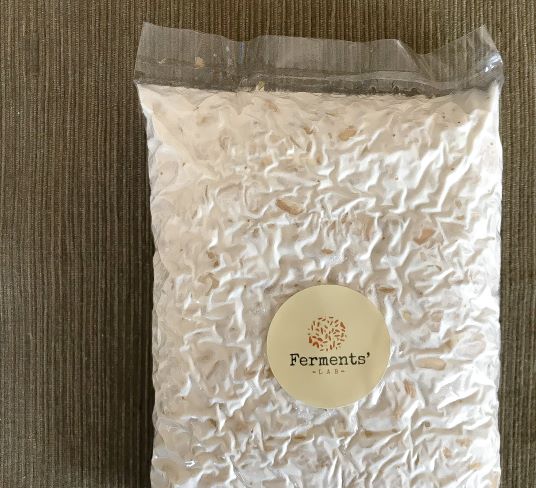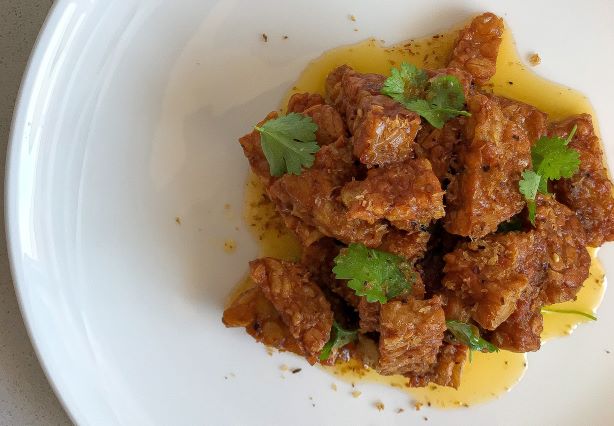If you were to order tempeh in Indonesia, it would be battered, doused in sweet soy and chilli sauce or served as is with white fluffy rice. But in Australia, tempeh is most embraced as a plant-based alternative.
The fermented ingredient has plenty of unlocked potential across multiple cuisines, and is just waiting for chefs to take the plunge.
Hospitality talks to Ferments Lab’s Darwin Su and Balinese Spice Magic’s Juliana Mitry about recreating the taste of home using Australian produce and introducing a sacred, long-guarded recipe into the mainstream culinary world.
When Juliana Mitry opened Balinese Spice Magic in Wollongong, her goal was to showcase local produce while maintaining the authenticity of Indonesian cooking.
“We do everything traditionally; I don’t use any machinery,” says Mitry. “Anything that’s still connected to humans or connected to feeling will be much better than putting it through machines.”
Alongside her restaurant, Mitry has launched an artisan tempeh brand called Tempeh Temple, which has aims to educate consumers on the benefits of sourcing fresh, locally made products.
“You can get tempeh from the Asian shop or big supermarkets, but it’s been in storage for a while coming from Indonesia or it’s processed,” says Mitry. “Whereas now there are a lot of young tempeh makers that give you real tempeh that tastes as close to Indonesian tempeh.”
Darwin Su had a similar goal when he started his side business Ferments Lab. The Banh Xeo Bar chef has a background in food science, which has been incredibly useful when it comes to making tempeh. “My mission is to introduce tempeh and educate people that it can be a versatile ingredient,” he says.
When it comes to making tempeh, the process of fermentation can be unpredictable and is dependent on temperature and timing, which is why preparation is crucial. While Su honours the traditional method, the Australian climate is vastly different to the tropical weather in Indonesia, which means ingredient adjustments need to be made to achieve the best-possible outcome.
“We use a lot of split chickpeas, split soybeans or split green peas,” says the chef. “With split beans and peas, it’s easier to cook and there is less soaking time. But if you use the whole beans, you need to soak them for at least 12 hours, but I normally do it for about 24 hours.”
Different beans can be used to make tempeh, but each type needs to be treated according to its characteristics. Mitry experiments everything from adzuki and mung beans to chickpeas, lentils and hemp seeds. After soaking, the legumes are dried in the sun before vinegars and bacteria are added to begin the fermentation process.
“We use the natural temperature rather than forced temperature,” says Mitry. “In winter, it generally takes about 36 to 40 hours, but you get the most perfect tempeh because it’s slowly incubating.”
Tempeh is fermented with a bacterium known as Rhizopus oligosporus, which comes in the form of a starter. “Some people will refer to it as yeast, but a tempeh starter is not actually yeast; it’s little, live microbes that have got rise,” says Mitry. “The microbes are like bacteria that eat through the beans.”
Su opts to feed the bacteria with apple cider vinegar. “It’s just to reduce the pH of the beans, so the bad bacteria won’t grow,” he says “Rhizopus can grow in a lower pH [and the vinegar] prevents cross-contamination.”

Su has a bespoke incubator which he uses for the fermentation process. “Traditionally in Indonesia, they use banana leaves and they can just leave it outside because the room temperature is already about 30 to 33 degrees Celsius, which is perfect for the bacteria,” he says. “But because Australia isn’t tropical, you need to have a constant temperature of 29 to 32 degrees Celsius for the bacteria to grow.”
The chef lets his tempeh sit for 36 hours at a constant temperature of 30 degrees Celsius. After 20-24 hours, the lid is then taken off and the tempeh is exposed to the air. At this point, it produces its own heat.
In terms of storage, tempeh lasts for a maximum of seven to 10 days when kept in the fridge. After the first few days, its appearance will start to change.
“Sometimes my customers freak out a bit with the colour if they are not familiar with tempeh,” says Su. “The colour will change on the surface; fresh tempeh has a perfect white mould, but in around three days, you will see some yellow and maybe some black spots, which is completely fine.
The black spots are just spores from the bacteria; it shows the tempeh is mature and reached its peak flavour-wise.”
In the same way as tofu, tempeh can be used as a building block in vegetarian and vegan dishes. But it has yet to make a breakthrough in the culinary industry despite its potential. Mitry and Su have set out to introduce tempeh to other chefs and change their perceptions on its uses.

“I haven’t really seen tempeh in a restaurant before,” says Su. “When I speak to bosses in cafes, they’re sort of reluctant to use it. People don’t know much about tempeh yet, so I think they’re a bit worried about whether they can sell it.”
One of the key benefits of tempeh is that it can be used in other cuisines besides traditional Indonesian food. “Recently, I made a classic Italian dish with cod fish and pea cream, but instead of the cod, I used tempeh,” says Su.
Balinese Spice Magic’s tempeh dishes cater to various types of diets, with vegans and meat eaters alike enjoying her artisan tempeh. “They’re happy to choose a variety of tempeh rather than go for meat, chicken and pork,” says Mitry. “Most people have been very positive about it.”
When it comes to tempeh, there is a degree of uncertainty, but it truly is the perfect example of science and patience. In its first stages, there are only a few elements that can be controlled, and in the end, it’s up to nature to run its course.
“My rule of thumb is basically like the three monkeys; no bad thoughts, no hearing bad things and no saying bad things,” says Mitry. “And generally, it always works. I don’t know if it’s because I’m superstitious, but where I grew up, making tempeh is basically making food from the heart.”
Sponsored Content

Tru-Pour barware – accuracy made easy
Sponsored by Tomkin

Summer insurance essentials for mobile food truck owners
Sponsored by BizCover
Trending Now
Resources
Lorem ipsum dolor sit amet, consectetur adipiscing elit. Fusce ac ornare lectus. Sed bibendum lobortis...
Lorem ipsum dolor sit amet, consectetur adipiscing elit. Fusce ac ornare lectus. Sed bibendum lobortis...
Sign up for our newsletter
